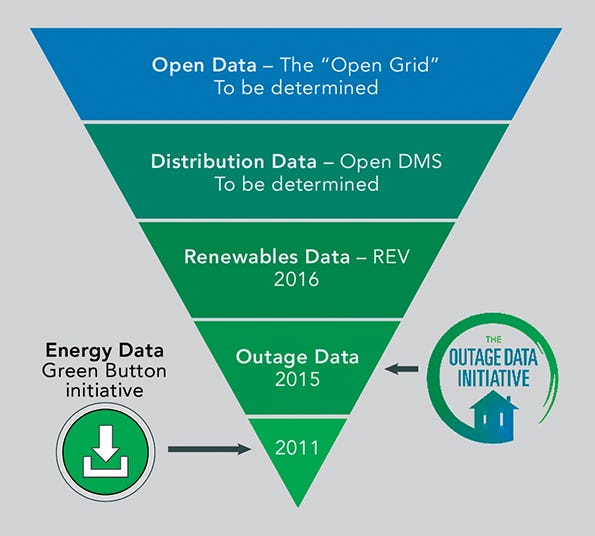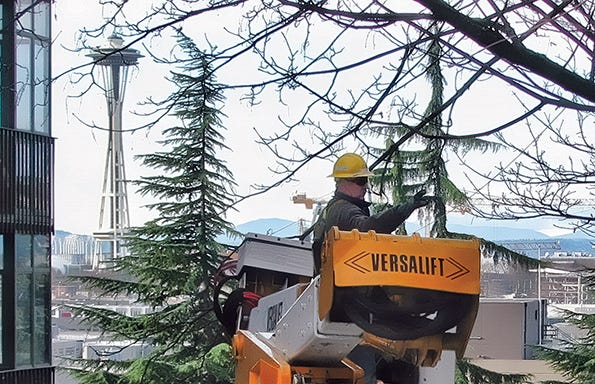Seattle City Light Shares Outage Data Initiative
Collaboration, standards and APIs will improve restoration and drive the next generation of utilities.
April 2, 2016

By IOT Content Manager
True change takes collaboration, passion and vision. For utilities, change means moving in a new and interoperable direction. Enter the Outage Data Initiative and its role in reshaping the electric utility industry. This includes the ability to share one’s outage data by embracing standards. In 2014, the White House Office of Science and Technology Policy (OSTP) challenged electric utilities and software providers to find an approach to share outage data, one that fostered power restoration and data availability during grid events. The OSTP message was simple: Embrace standardization and best practices in data sharing to empower consumers, first responders, surrounding utilities and governmental bodies with information during power outages.
While the challenge spoke to the heart of the utility open data movement, it represented an industry first: the opportunity to unlock spectacular gains in efficiency for utilities by embracing standards and application programming interfaces (APIs) to share outage data with those who need it — other utilities, customers, vendors, government officials and first responders. Think of an API as a contract. It details the exact structure of request and response. It provides a documented, upfront approach on how to work with data and will remain constant over time.
The challenge aligned with trends in the outage management solutions industry. Ask any utility executive what is changing in the grid and the leader will surely reference the relation of service reliability and the rise of customer expectations. This overarching theme — to provide timely and accurate outage and restoration information — is driving many utilities to test new technologies, processes and solutions that enable resiliency and align with customer expectations. When the Electric Power Research Institute (EPRI) and like-minded utilities mobilized around the Outage Data Initiative to enable the sharing of outage data, they knew it would require a never-before-seen level of teamwork. This sharing would unite the industry and vendor community.
What Is the Outage Data Initiative?
Data sources can be difficult to integrate, and the push toward standardization in the distribution grid has just begun. Realizing efficiency and building the next-generation utility means embracing change. While Thomas Edison is given credit for building the foundation of today’s grid, a long-standing question remains: How can the data the grid provides be shared with those who need it?
This question led EPRI to sponsor the Outage Data Initiative. EPRI recognized the need to develop a common standard for outage messaging and process to share outage data:
A solution and process to leverage APIs to benefit utilities, customers, first responders and government
A simplified approach for how other developers access and realize benefit from the standardization of data
A mechanism to showcase grid-interoperability visions that includes the process, technology and use-case documentation for interoperability
A chance to demonstrate the first true instance of utility-to-utility interoperability, allowing utilities to share data with each other
Utilities currently present outage information in map displays; however, events like Hurricane Sandy show the need for overlapping utilities to share this information through a common information model to facilitate collaboration among first responders, utilities and customers during critical events.
EPRI understands the efficiency gains that come from sharing outage data in numerous areas, including crew staging, proactive customer messaging, empowered customers and new types of robust outage prediction algorithms. The bottom line is the ability to share outage data could help to get the lights back on faster and possibly save lives.

The Outage Data Initiative is the next step in a progression to improve disaster response and recovery efforts.
Call for Action
EPRI laid out a clear vision. The messaging would be designed to be published to a group of pre-approved subscribers (through authenticated access to an API) who could consume the outage information. To achieve this vision, tasks needed to be compartmentalized in the following ways:
Standard. Global standards leader Sisco led the messaging structure process. The standard was created for the outage data and approved by the International Electrotechnical Commission (IEC). The standard chosen was the common information model (CIM), an open standard that defines how managed elements in an IT environment are represented as a common set of objects and relationships between them. The standard message was designed so utilities with a variety of different information system capabilities could offer comparable data and support progressive enhancements in data, as may be required during the response to major disasters. Using this standard, data can be transferred in a common format to a secure location, where information is consistently defining outages for a specific region. This could include areas covering multiple utility territories or even the entire nation.
Software development. Industry newcomer DataCapable has been the technical resource for the initiative and has been involved in all aspects of the project. This includes the support and design of the API, authentication, security and IT architecture. DataCapable collaborated and coordinated with numerous outage management system providers and outage mapping tools to ensure the executed vision represented collaboration. This collaboration included working with team members from Oracle, Siemens, iFactor, Esri, EPRI, OMNETRIC Group and Accenture.
Business value. Boreas Group was tasked with defining how customers, utilities and emergency-response stakeholders would derive value. In this role, Boreas Group supported the business process changes and associated messaging to realize the value of standardized outage data: This included enabling the interoperability value with neighboring utilities, state and local government, TV, radio, utility web, police, fire, other utility vendors, etc.
Utility support. Utilities from across the U.S. supported the efforts and value exploration of this initiative. The utilities included ComEd, Baltimore Gas and Electric, Iberdrola, Commonwealth Edison, Duke Energy, Florida Power and Light, National Grid, Pacific Gas and Electric, San Diego Gas & Electric, Seattle City Light, Emera Maine, Hart EMC and Southern California Edison. The feedback on authentication, granularity and capabilities helped to define a process that was both needed and supported.
Building the Architecture
To get involved, utilities will need to change the structure of the data being provided to third parties. The translation of outage data to the CIM standard has been documented by the supporting members. Outage data is obtained from the outage management system (OMS) or other utility application tasked with keeping track of outage events. The outage data is typically stored in staging tables. OMS vendors are encouraged to embrace the CIM standard (as many already do) to eliminate the need for the translation of data formats. Utilities can then publish their data through a secure web service, or by uploading it as a file to a shared and secured location, in the CIM standard. Data is then provided in multiple formats (XML, JSON, GeoJSON) through the API. The Outage Data Initiative team documented this process, and utility teams have showcased the adoption and publishing mechanisms in as little as a day.
Proving It Works
At DistribuTECH 2015, more than 11,000 utility participants and industry leaders witnessed the outage data standardization progress. EPRI demonstrated the first phase of the work to show how outage data could be broadcast through multiple media channels.
During this demo, historical outage data from Baltimore Gas and Electric, Central Maine Power, Commonwealth Edison, Duke Energy, Florida Power and Light, National Grid, New York State Electric and Gas, Pacific Gas and Electric, Rochester Gas and Electric, San Diego Gas & Electric and Southern California Edison was standardized and shared in real time across the DistribuTECH floor. Numerous vendors, including AGSI, DataCapable, Esri, OMNETRIC, Accenture and Siemens subscribed to the simulated outage events, all in real time. For the first time in grid history, data was shared across utilities as well as the product and service community. Even though the architecture and value are now proven, the supporting teams knew more had to be done.
Seattle City Light Gets Involved
When Seattle City Light heard about the Outage Data Initiative in the summer of 2014, it knew the value had to be proven. Unbeknownst to EPRI and others supporting the Outage Data Initiative, Seattle City Light was the first adopter and promoter of open data in the energy industry through the Green Button standard. The utility understood the value of open data and had even built its own outage map a few years prior. At the time, the need to share outage data across departments at Seattle City Light, along with other stakeholders, was well understood. Police, fire and transportation would all benefit from understanding where large outages were impacting Seattle residents. In fact, there is regular interaction with these parties in leading communications and public affairs.
The challenge was the lack of a standard or an agreed-upon process to share Seattle City Light’s outage data. The utility’s team recognized a few one-off integrations to specific parties would be easy to manage, but without widespread adoption of a standards-based approach, enabling that vision for the entire industry was not going to happen.
For Seattle City Light’s personnel, getting involved in the Outage Data Initiative meant rolling up their sleeves. It also meant realizing how the line between information technologies and operational technologies is blurring for utilities. The challenge was to capture how changes in data management, integrations and standards could enable more meaningful relationships with third parties, such as emergency response and surrounding utilities, during grid events. Being an early explorer of outage data sharing also provided an opportunity to help drive industry progress.
Under the guidance of EPRI and internal support, Seattle City Light started developing; pushing the ball in a new direction means trying new things. Over the course of a week, the utility went from giving it a shot to being the first to embrace it. In fact, it is estimated the translation to the standard and pushing to the outage sharing tool took less than 10 hours. It also provided Seattle City Light an opportunity to share its outage data with the surrounding utilities, something the Seattle City Light team hopes other Pacific Northwest utilities will embrace. By embracing standards and collaboration, utilities will benefit from significant cost savings related to integration while empowering new developers and vendors to leverage this much-needed data set in their own applications.

Implementation Demo
DistribuTECH 2016 will build on the progress showcased during the 2015 event. To celebrate this year’s progress in technology, EPRI is inviting DistribuTECH attendees to visit its booth and physically press the outage button. With each press, a CIM standardized outage post will be shared with the product and service providers showcasing their systems on the floor: OMNETRIC, DataCapable, Esri, Oracle, OSIsoft, Siemens, Accenture and more. This demo will bring with it many firsts for the industry:
The first time smart devices are used for customer outage notifications
The first time outages are consolidated from multiple utilizes in a standard way
The first time outage data is coordinated between all utility information channels
The first time inter-utility, multi-platform interoperability has been demonstrated on the floor of a conference.
In 2015, John Simmins of EPRI, demonstrated how historical outage data can be shared in real time with vendors across the floor.

Acknowledgements
The authors would like to thank Denice Ross, of the White House Office of Science and Technology, for her vision toward this work. They also would like to thank Zac Canders and Pete DiSalvo, cofounders of DataCapable, for their development and support in making this vision a reality. And finally, a special thank you to Margaret Goodrich for her dedication and passion toward standards development in the utility industry.
Article was originally published on TD World
You May Also Like






